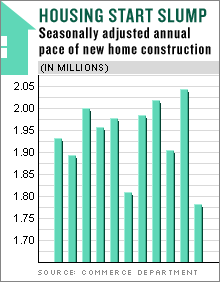NEW YORK (CNN/Money) -
Housing starts and new home sales took their biggest tumble in almost 11 years in November, raising worries about the housing market and the strength of home prices in the long run.
Sales of new homes unexpectedly plunged in November at the sharpest rate in more than a decade, falling 12 percent to the weakest annual rate since July, the Commerce Department said on Thursday.
The November sales tumble, which was well below Wall Street forecasts for a 1.20 million unit rate, followed a revised 4.2 percent increase in October to a rate of 1.278 million. Previously, the October rate had been reported as 1.226 million.
The Commerce Department said starts on new homes and apartments slumped 13.2 percent to a seasonally adjusted annual rate of 1.77 million last month from a revised 2.04 million pace in October. Economists surveyed by Briefing.com forecast housing starts would come in at a 1.98 million pace.
The monthly drop in housing starts and new home sales was the biggest percentage decrease since January 1994, according to the deparment. Total starts fell to the lowest level since May 2003.
But while some economists said the drops bear watching, they also said it was probably too soon to say it meant the housing bubble was ready to burst.
Building permits, considered a gauge of home builders' confidence in the market, came in at an annual pace of 1.99 million, down 1.5 percent from October and also below forecasts of 2.02 million.
The drop in ground-breaking for new homes hit all regions of the country. Starts slumped 19 percent in the Midwest, 14 percent in the Northeast, 13 percent in the West and 10 percent in the South.
While new home sales are a relatively small part of the overall housing market, economists watch sales and home construction for any signs of weakness. Sales of existing homes, by contrast, are tallied later, after closing, normally a month or two after contracts are signed.
Mortgage interest rates edged higher last month from October but were still near six-month lows. The average 30-year fixed-rate loan was 5.73 percent last month, according to mortgage firm Freddie Mac -- near the lowest since March.
Mortgage rates on the rise?
Still, with the Federal Reserve raising short-term rates again this week and the federal budget deficit growing, many expect the longer-term interest rates that determine mortgage rates to rise in 2005.

"Rates might be low, but people are starting to realize that rates will go up," said Anthony Chan, senior economist with JPMorgan Fleming Asset Management. "Remember you've got to get a mortgage down the line, maybe six months out when the home is complete. People are preparing for it."
Chan said that there's enough volatility in the monthly numbers to not take Thursday's report as a sign of the bursting of the housing bubble, especially since building permits stayed relatively strong. But he warned against ignoring the report either.
"This report shows that this sector cannot defy the laws of gravity," he said. "As rates rise or prepare to rise, one will undoubtedly see a slowdown in this sector. And while we may not see prices fall in 2005, we'll definitely see the pace of growth slow. There's no question that housing price valuations don't wear bullet-proof vests."
But some other economists said those calling this the beginning of the end of the so-called housing bubble were overreacting.
"The outsized decline in starts in November is a bit confusing given the steady and elevated pace of permitting over the last several months," Wachovia Securities economist Gina Martin wrote in a note to clients. She said that shortages of materials and contractors due to work rebuilding damaged homes after this year's four big hurricanes may explain part of the decline.
Martin said the fall in housing starts brings it in better balance with the demand for new homes, adding that the supply of new homes remains tight, which should help support the real estate market.
"Long-term mortgage rates remain stubbornly low and will provide additional support to demand in the near term," she wrote.
Still, the much weaker-than-expected numbers will increase the attention for the new home sale report due next Thursday and the existing home sales report the following week.

|

